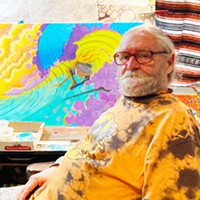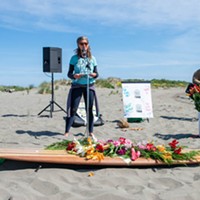
Photo courtesy of Hollie Ernest
The author with her board, fresh from Humboldt's waters.
[
{
"name": "Top Stories Video Pair",
"insertPoint": "7",
"component": "17087298",
"parentWrapperClass": "fdn-ads-inline-content-block",
"requiredCountToDisplay": "1"
}
]
Some sports are like foreign languages — infinitely easier to learn when you're younger. Once humans reach a certain age, our hips, knees and balance operate as they always have, and it's much harder for our body to move in new, contrasting directions. For example, if you are a runner or a cyclist, your joints are used to moving bilaterally, forward and backward, but not side to side. Similarly, languages are easier to learn at a young age because the brain is still elastic and neural pathways are still forming. The body is not yet so set in its ways.
At 36, my sense of balance is what it is and doesn't seem to be improving much, despite my best efforts. Learning how to surf over the past year has felt rickety at best and impossible at worst. Young surfers glide by me, making it look easy in choppy, unpredictable conditions. Meanwhile, I am paddling for waves that often leave me behind, while the aforementioned young surfers stand on their boards in the most relaxed postures, like they are waiting for the bus.
It might be too late for me to become fluent in surfing, French or Spanish, but I keep trying to learn at least some words and movements, forcing my brain to take paths or make connections where it doesn't want to. My joints sometimes feel like they missed a turn and can't quite work in the ways that I wish they would, but I still go out to surf. This morning, when I was staring at the nearly full waning moon to the West, I wasn't thinking about my bad right hip, or my healing rotator cuff. I was just happy to be out there, content to be in touch with my surroundings, watching pelicans gliding a foot above the water and the sandpipers picking at the sand in the shorebreak. I was keenly aware it was just past low tide. Being aware of the tides is new to me, and one of my favorite parts of this new hobby (surfing is certainly a sport, but I still hesitate to call what I do out there a sport). More than anything, this in-tuneness is what gets me out. Gets me out of the house, gets me into the water and makes me feel alive, no matter the season.
Watching the sunrise from the water, a unique vantage point, has become one of my greatest joys in life. The distant golden orb advances from the East and illuminates the clouds in its soft, foamy light, reaching the westernmost water and rocks first. Watching the glow spread from Camel Rock to shore is pure delight. But you don't have to pick up surfing to see this; in fact, at the behest of territorial surfers and due to limited space in the water, I'm not encouraging (or discouraging) you to do so.
There are other avenues to get on the water for sunrise, sunset or midday. It doesn't matter how or where. Borrow a stand up paddleboard from a friend, or rent a kayak from Cal Poly Humboldt's Center Activities (visit centeractivities.humboldt.edu; you don't have to be a student), or get a good wetsuit and take a dip in one of our huge, brackish lagoons. Pay attention to the tides and the water levels, and pretty soon you too will have familiar landmarks in odd places throughout Humboldt County. Lagoon swimmers are familiar with, "the Snag" at Big Lagoon, a sun-bleached tree skeleton that for years has been laying on its side with its root wad facing East (0.9 miles from the boat ramp, if you were wondering). There are muddy spots further out in Big Lagoon and a sometimes-submerged snag laying on its side in Stone Lagoon. There's the anchored tree in the Mad River, placed there for salmon habitat. Countless trees, rock formations, sand bars and other landmarks serve as friendly orientation guides and markers of change in that place.
Knowing the coast, the tides, the shells and other creatures we share the world with gives a deeper meaning to our own existence. It feels like sitting down to pen a letter to an old friend — something intangible is exchanged, with knowledge or information passed from one being to another. With a letter, pen meets paper and words conglomerate to convey feelings, ideas and past events. When we write letters or even emails, we are making an effort to stay in touch with a person or persons. When we know the tides, natural landmarks and migration patterns of our neighbors, we are making an effort to stay in touch with the dynamic, ever-changing landscape of other lives around us.
If you're averse to being in the water, or to mornings, no need to fear. There are plenty of other opportunities to stay in touch. We already passed the King Tides (Jan. 21 and 22) but there are low enough tides in other months for decent tide pool viewing, if the weather isn't howling. Or snowing. Trinidad State Beach is a great place to look at tide pools, but so are College Cove, Moonstone Beach and Baker Beach. With any luck, you'll be able to say, "Hi," to the anemones and starfish.
This morning, as I watched a friend paddling toward me, I didn't think about how bad I am at actually catching waves. I thought about the tides and the pelicans and how just knowing this moment — just being there — felt right. I splashed the water with my hand and felt like I was in touch with the ocean, if only a tiny part of it.
Hollie Ernest (she/her) is a botanist and forestry technician. She is writing a book about her international bike adventures, gardening and exploring the corners of Northern California. Find her on Instagram @Hollie_holly.
Speaking of Surfing, Paddle Boarding
-

Wet and Wild on Woodley
Jul 21, 2022 -

Butch Cornelius' Surf Art History
Apr 21, 2022 -

Photos: Paddle Out for Justice
Jun 7, 2021 - More »
more from the author
-
Humboldt Ladies MTB Pedals Among the Pines
- Jul 14, 2022
-
Sea to Summit: A Return to Salmon Mountain
- May 26, 2022
-
Sea to Summit: King Peak
- Apr 7, 2022
- More »
Latest in Get Out
Readers also liked…
-
A Walk Among the Spotted Owls
- Apr 27, 2023































